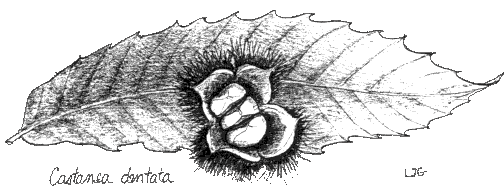
For an American chestnut revival in this lifetime, we need to graft the best genes into the best environment. This work will require an army of volunteers, cooperating with professional foresters. Join in the work by contacting the ACCF or your Ranger Station in the Jefferson & George Washington National Forests in Virginia, the Monongehela National Forest in West Virginia, the Nantahala or Pisgah National Forest in North Carolina, the Cherokee National Forest in Tennessee, or the Daniel Boone National Forest in Kentucky. Whenever clearcutting, fire, insect or storm damage creates an opening on a preferred site, we must reclaim that site for American chestnuts.
reprinted from VIRGINIA COOPERATIVE EXTENSION
VPI&SU EXTENSION FORESTRY NOTES, Summer 1993
![]()
An American chestnut revival is underway in several carefully selected forest clearcuts. On these sites Griffin and Elkins are testing an integrated management plan which combines managed cutting with the introduction of improved American chestnuts and hypovirulent strains of the blight fungus.
Hypovirulence, the result of a viral infection of the blight fungus, can slow down and weaken disease progress. It occurs naturally or can be purposely introduced into forest environments. This form of biocontrol has been used against chestnut blight in French and Italian groves, where European chestnuts were inoculated with hypovirulent strains of the fungus, permitting the trees' defenses to prevail.
However, hypovirulence has had variable success in the US. American chestnuts are considered to be more susceptible to blight than are European chestnuts. Furthermore, in forest competition (vs. groves), the conditions are less favorable for establishing biological controls. These difficulties may be overcome by American chestnuts with improved blight resistance and simple management practices to establish small forest groves on preferred American chestnut sites.
Before blight killed them, chestnuts were the predominant hardwood species in the Appalachians in Virginia and West Virginia, growing to huge dimensions and in nearly pure stands in certain areas of the southern Appalachians, northern Blue Ridge, and Ridge and Valley sections. Where the forest has been clearcut, they have sprouted vigorously from the old roots, growing as rapidly as any other tree and competing well until killed back by the blight. Since blight does not kill the roots, new chestnut shoots emerge. Sometimes they catch up to the other trees before they are again killed by blight. Their next shoots are the youngest growth in the area. Deer and rabbits browse them heavily, and any chestnuts to escape are at a great disadvantage. In addition to the stresses from disease and animals, they are now shaded out by the other trees. Thus, within 13 years following clearcutting on the best forest sites, all the American chestnuts are dead.
In this way, as clearcuts age past the deadline, we are losing the root stocks which could hold these sites for American chestnut regeneration. Preferred sites are identified by the presence of large chestnut stumps or snags; numerous chestnut sprouts, and other species that share similar site preferences, such as tulip poplar, northern red oak, and cucumber magnolia. Frequently, the best chestnut sites are located in shallow coves with a northerly aspect. Chestnuts in clearcuts of this description can be saved by cutting competing trees within a 10-foot diameter around each chestnut stem, leaving all blighted and dead chestnuts standing and maintaining the openings through biennial cutting.
Test plots managed in this way produce chestnut mast crops within a few years. Although individual stems may still succumb to blight, they are continuously replaced by new ones. Management also stimulates continuous cycles of blight, which encourages an ecological succession in the blight fungus -- spontaneously, hypovirulence appears.
The weakening of blight disease on a managed site may be further enhanced by introducing hypovirulent strains which have controlled blight elsewhere. At the same time, American chestnuts with improved blight resistance are introduced by grafting into available root stocks. The introductions are all-American intercrosses that combine resistance from several native American chestnuts which have survived the original blight epidemic and tested positive for blight resistance. Developed by the ACCF, the all-Americans have low levels of blight resistance which may be magnified by the addition of new discoveries (an American chestnut should be at least 10 inches DBH and have blight cankers) and more generations of breeding, in pursuit of resistance levels capable of returning the American chestnut to timber production.
Through cooperative efforts with the USDA Forest Service, their forerunners have been grafted into selected aging clearcuts where the integrated management plan was established in the Jefferson and George Washington National Forests in Virginia and in a few places in West Virginia, North Carolina, and Maryland. Westvaco and Georgia-Pacific are now in the process of identifying appropriate sites for managed American chestnut regeneration in their forests. Other forest landowners who wish to join this effort may contact: ACCF, 2667 Forest Service Road 708, Newport, VA 24128. Managed plots will be entered into a database for use in future Foundation grafting clinics and, when funds become available, for extension of the biocontrol.
Right now we believe that the work of identifying and managing the best chestnut sites in aging clearcuts must be the most urgent priority. While efforts will remain on track to further improve resistance breeding and refine viable biocontrol strategies, the final dimensions of American chestnut restoration cannot exceed the total area which has been dedicated to the integrated management plan. In the short term, an American chestnut revival promises to improve the habitat for wildlife; over the long haul --the forest heritage of future generations.
![]()
For references to scientific papers which offer more details about this project and the science upon which it is based, go to the second half of the Bibliography.
Return to the American Chestnut Cooperators' Foundation home page